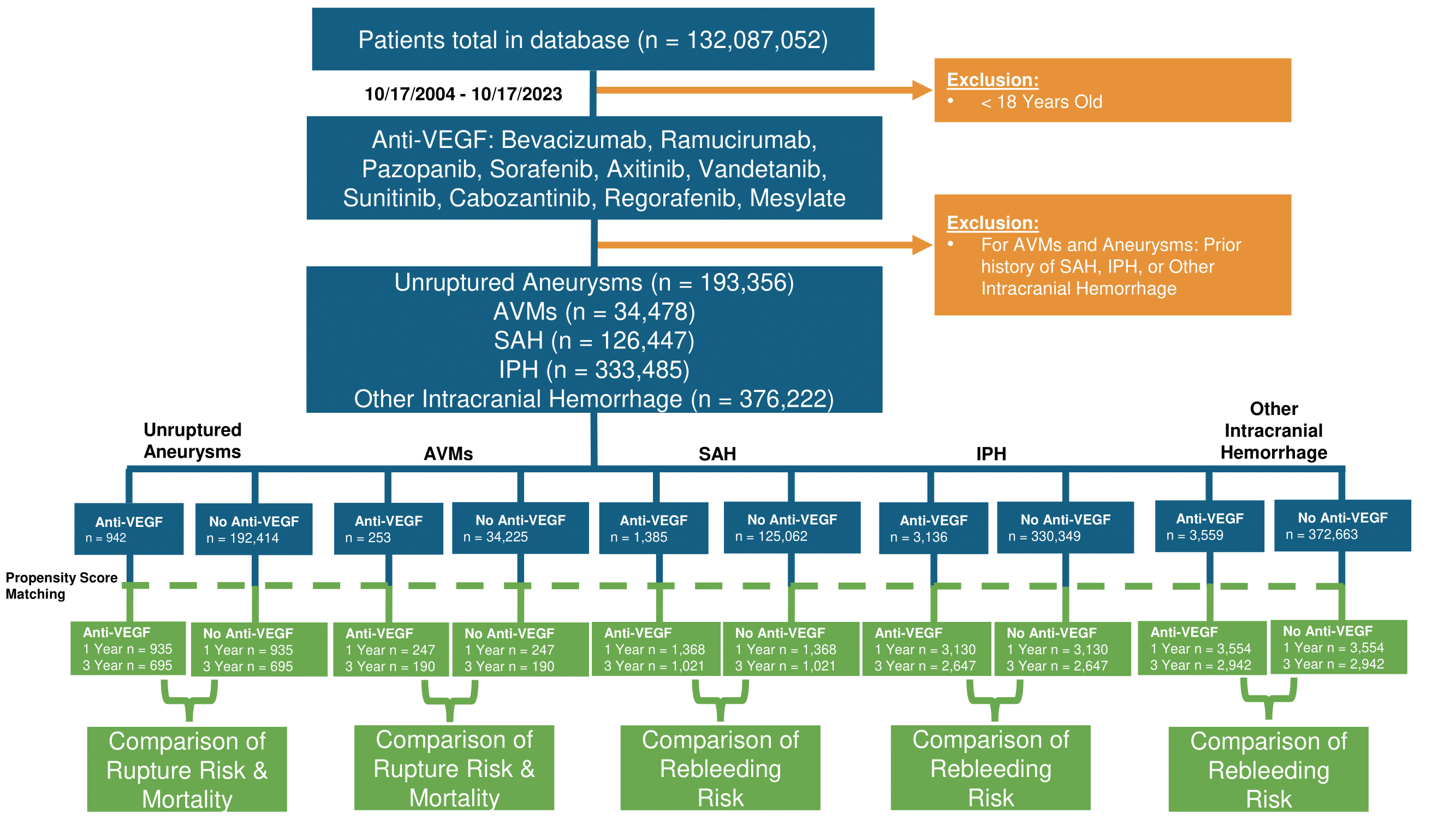Final ID: LBP4
Impact of Anti-Vascular Endothelial Growth Factor Agents in Patients at Risk for Non-Traumatic Brain Hemorrhage
Abstract Body: Objective: To evaluate the impact of anti-VEGF agents in unruptured cerebral arteriovenous malformations (AVMs), aneurysms, and prior hemorrhage.
Methods: Using the TriNetX database, we conducted a cohort study comparing patients with unruptured AVMs, aneurysms, non-traumatic subarachnoid hemorrhage, intraparenchymal hemorrhage, and other intracranial hemorrhages treated with anti-VEGF agents versus untreated controls. Propensity score matching was employed to balance demographics, comorbidities, neoplasms, and medication use. Hemorrhage rates, mortality, and rebleeding were assessed at 1- and 3-year follow-ups.
Results: For aneurysms at 1 year (n = 935 per group), anti-VEGF had no significant difference in hemorrhage risk (OR = 1.00, 95% CI 0.64–1.56, p = 0.999) but increased mortality (OR = 1.68, 95% CI 1.26–2.27, p < 0.001). At 3 years (n = 695 per group), anti-VEGF increased hemorrhage risk (OR = 1.55, 95% CI 1.03–2.34, p = 0.034) and mortality (OR = 1.92, 95% CI 1.48–2.52, p < 0.001). For AVMs at 1 year (n = 247 per group), no significant differences were found in hemorrhage (OR = 1.00, 95% CI 0.40–2.51, p = 0.999) or mortality (OR = 1.37, 95% CI 0.67–2.87, p = 0.388). At 3 years (n = 190 per group), hemorrhage risk remained non-significant (OR = 0.50, 95% CI 0.22–1.10, p = 0.086), but mortality increased (OR = 2.02, 95% CI 1.19–3.48, p = 0.008). Anti-VEGF use increased rebleeding risk at 1 year in SAH (n = 1,368 per group, OR = 1.28, 95% CI 1.07–1.52, p = 0.006), IPH (n = 3,130 per group, OR = 1.14, 95% CI 1.03–1.26, p = 0.013), and other intracranial hemorrhages (n = 3,554 per group, OR = 1.12, 95% CI 1.02–1.23, p = 0.016). Increased rebleeding risk persisted at 3 years in SAH (n = 1,021 per group, OR = 1.28, 95% CI 1.07–1.52, p = 0.012), IPH (n = 2,647 per group, OR = 1.25, 95% CI 1.13–1.40, p < 0.001), and other hemorrhages (n = 2,942 per group, OR = 1.32, 95% CI 1.18–1.48, p < 0.001).
Conclusion: Anti-VEGF treatment is associated with increased hemorrhage risk in unruptured aneurysms and elevated mortality in both AVM and aneurysm patients. The lack of increased hemorrhage in AVMs may be due to inhibition of abnormal vessel formation. Additionally, anti-VEGF increases rebleeding risk in patients with prior non-traumatic SAH, IPH, and other intracranial hemorrhages. The need for Anti-VEGF treatment should be balanced against hemorrhage risk in patients with intracranial vascular malformations and those with history of intracranial hemorrhage.
Methods: Using the TriNetX database, we conducted a cohort study comparing patients with unruptured AVMs, aneurysms, non-traumatic subarachnoid hemorrhage, intraparenchymal hemorrhage, and other intracranial hemorrhages treated with anti-VEGF agents versus untreated controls. Propensity score matching was employed to balance demographics, comorbidities, neoplasms, and medication use. Hemorrhage rates, mortality, and rebleeding were assessed at 1- and 3-year follow-ups.
Results: For aneurysms at 1 year (n = 935 per group), anti-VEGF had no significant difference in hemorrhage risk (OR = 1.00, 95% CI 0.64–1.56, p = 0.999) but increased mortality (OR = 1.68, 95% CI 1.26–2.27, p < 0.001). At 3 years (n = 695 per group), anti-VEGF increased hemorrhage risk (OR = 1.55, 95% CI 1.03–2.34, p = 0.034) and mortality (OR = 1.92, 95% CI 1.48–2.52, p < 0.001). For AVMs at 1 year (n = 247 per group), no significant differences were found in hemorrhage (OR = 1.00, 95% CI 0.40–2.51, p = 0.999) or mortality (OR = 1.37, 95% CI 0.67–2.87, p = 0.388). At 3 years (n = 190 per group), hemorrhage risk remained non-significant (OR = 0.50, 95% CI 0.22–1.10, p = 0.086), but mortality increased (OR = 2.02, 95% CI 1.19–3.48, p = 0.008). Anti-VEGF use increased rebleeding risk at 1 year in SAH (n = 1,368 per group, OR = 1.28, 95% CI 1.07–1.52, p = 0.006), IPH (n = 3,130 per group, OR = 1.14, 95% CI 1.03–1.26, p = 0.013), and other intracranial hemorrhages (n = 3,554 per group, OR = 1.12, 95% CI 1.02–1.23, p = 0.016). Increased rebleeding risk persisted at 3 years in SAH (n = 1,021 per group, OR = 1.28, 95% CI 1.07–1.52, p = 0.012), IPH (n = 2,647 per group, OR = 1.25, 95% CI 1.13–1.40, p < 0.001), and other hemorrhages (n = 2,942 per group, OR = 1.32, 95% CI 1.18–1.48, p < 0.001).
Conclusion: Anti-VEGF treatment is associated with increased hemorrhage risk in unruptured aneurysms and elevated mortality in both AVM and aneurysm patients. The lack of increased hemorrhage in AVMs may be due to inhibition of abnormal vessel formation. Additionally, anti-VEGF increases rebleeding risk in patients with prior non-traumatic SAH, IPH, and other intracranial hemorrhages. The need for Anti-VEGF treatment should be balanced against hemorrhage risk in patients with intracranial vascular malformations and those with history of intracranial hemorrhage.
More abstracts on this topic:
Can the reduction of mutant endothelial cells hold promise for treating brain arteriovenous malformation?
Shabani Nabikandi Zahra, Prado Leandro, Shaligram Sonali, Zhang Rui, Zhu Wan, Liang Rich, Yadav Alka, Wang Calvin, Su Hua
3D Aortic Geometry is Informative for Risk of Adverse Aortic EventsPirruccello James
Readers' Comments
We encourage you to enter the discussion by posting your comments and questions below.
Presenters will be notified of your post so that they can respond as appropriate.
This discussion platform is provided to foster engagement, and simulate conversation and knowledge sharing.
You have to be authorized to post a comment. Please, Login or Signup.
Rate this abstract
(Maximum characters: 500)



